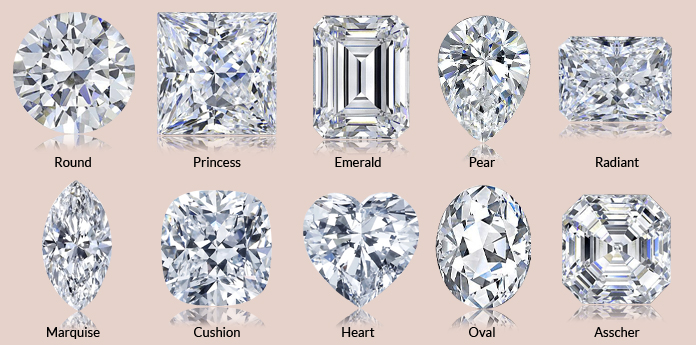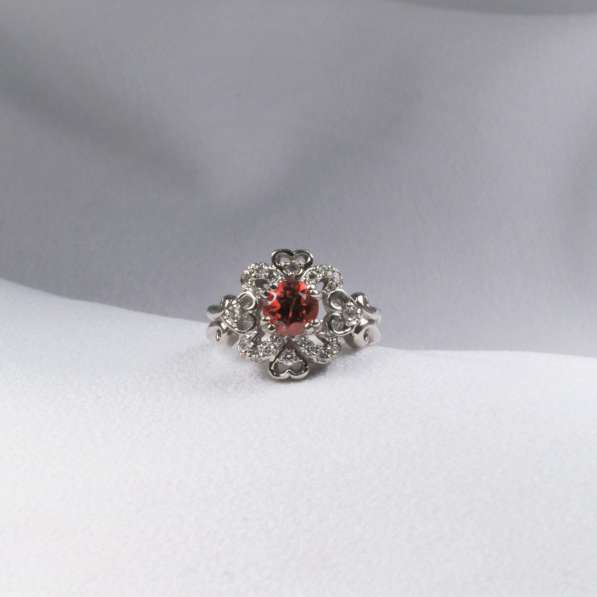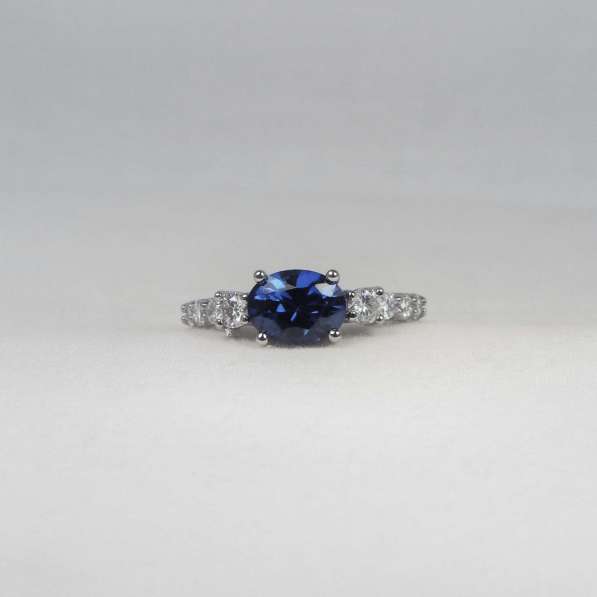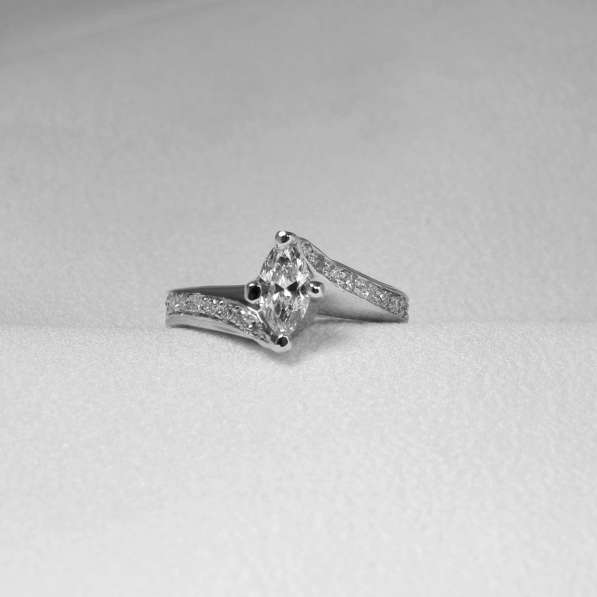Thinking about popping the big question? Great! Sounds like you’ve found the love of your life, but have you found the right engagement ring? Maybe you’re completely overwhelmed by the process and pricing. No need to worry, finding the right engagement ring doesn’t require you to be an expert jeweler. With a little bit of help, you can be on your way to buying the ring of your partner’s dreams.
The average proposer spends nearly five months planning the day when they drop to one knee and ask those beloved words, “Will you marry me?” So if you’re ready for that next step with your partner, finding the right ring plays a central role in your big day. Before we dive into the details of what makes an engagement ring unique and timeless, you need to answer two questions.
- Is your partner coming to look with you?
- What is your budget?
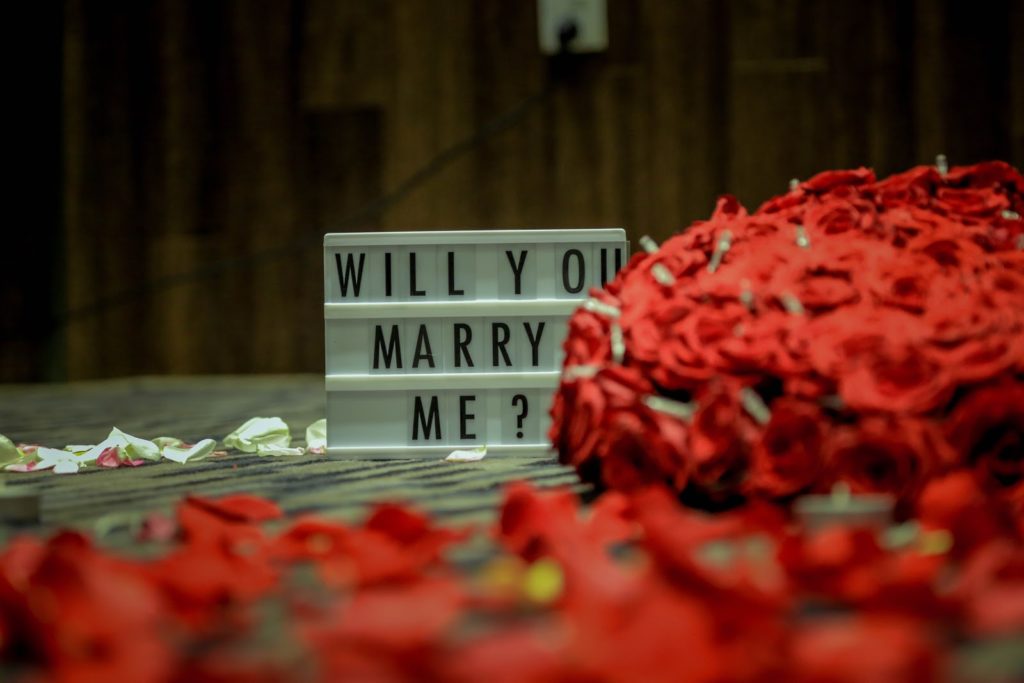
Looking Together vs. Alone
The difference here is if you’re trying to make the proposal a total surprise! Looking alone allows you to have the element of surprise on your side, and maybe that aligns perfectly with what you and your partner envision the proposal to feel like. By looking alone you should have a pretty good idea of what your partner likes and values in their engagement ring. They say diamonds are a girl’s best friend, but ultimately she still needs to like the ring — no matter how big the stone is. This requires you to speak to your partner’s closest confidants and get their opinion about what their style looks like. However you get an idea of their style, it’s better to come to the jeweler with a starting point.
At the same time, deciding to look at rings together can be a special experience for you and your partner. Your partner will be better to express to the jeweler what their style looks like, and what other possibilities they might also enjoy. Going together also helps reduce the need to return for a sizing or style issue.
Picking a Budget
There is an old saying that an engagement ring should cost two month’s salary. That just isn’t true. Buying an engagement ring should be an empowering choice, not a debt-filled requirement. Therefore, discussing your realistic budget with your partner’s ring expectations is an important conversation to have. Currently, the average engagement ring cost is somewhere around $6,000 — give or take a few hundred dollars. Yet, this in no way obligates you to spend this much. You should be able to spend less or more based on your financial situation. You can find beautiful, timeless engagement rings at any price point. When you decide to visit the jeweler come in with an estimated budget to help zero-in on the right ring options for you and your partner.
The Ring Basics – The 4 Cs
Most engagement rings feature a white diamond, and if you’re thinking about going the traditional route with this stone, you should know about the 4Cs. These four elements help define the style and price of the diamond and engagement ring.
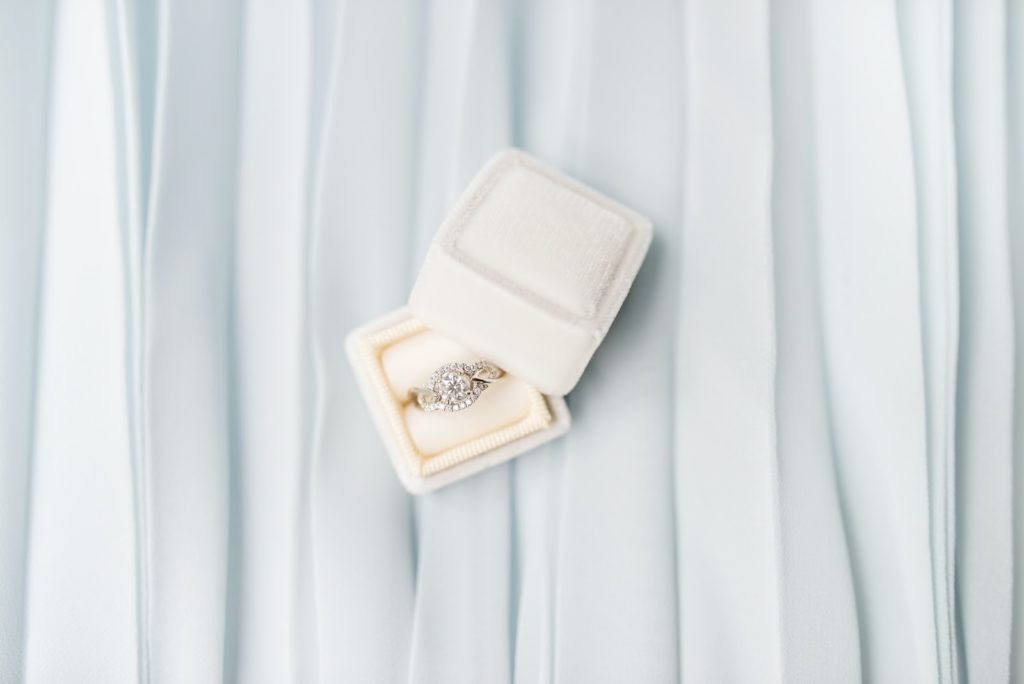
Cut
The cut of a diamond deals with the angle and proportions in which the stone sits. The different cuts change how the diamond looks and reflects light — this is arguably the most important factor in the price and shine associated with the stone. Diamond cutting has evolved today by the aid of computers and a Sarine analysis which can tell a diamond cutter the perfect proportions for cutting the stone for optimum potential. Three important aspects to the cut include:
Brilliance: Brightness created from a combination of reflected white lights
Fire: Flashes of spectacular color seen through all aspects of the diamond
Scintillation: Areas of light and dark that reflect when the diamond is moved
Today G.I.A. has a cut grading system for Brilliant Cut Round diamonds only. These have many factors which include polish, symmetry, depth and table percentages, just to name a few. These grades are as follows:
- Excellent
- Very Good
- Good
- Fair
- Poor
Shape (Expansion of Cut)
The cut also involves the true shape of the diamond. The shape in which a diamond is cut brings out different beauty aspects of the stone. In addition, the variety in shape gives an individual the ability to customize their engagement ring style.
Some popular diamond cuts include:
Round Diamonds: The round cut diamond is the most popular diamond shape. Approximately 75 percent of all diamonds sold are of this shape. Due to the mechanics of the round diamonds’ shape, it is generally superior to fancy diamond shapes at the proper reflection of light, maximizing potential brightness. Because of its high demand, round diamonds typically cost more on a per carat basis.
Princess Cut Diamonds: The princess cut diamond is the most popular fancy cut, especially when it comes to engagement rings. Similar to round cut diamonds, princess cut diamonds are a good choice for their flexibility in working with almost any style of ring. Princess cut diamonds typically have a slightly lower price-per-carat than round cut diamonds.
Emerald Cut Diamonds: Emerald cut diamonds have a unique look that is created by the step cuts of its pavilion and its large, open table. Instead of the sparkle of a brilliant-cut, emerald cut diamonds produce a hall-of-mirrors effect because of the interplay of light and dark planes. Its long lines and dramatic flashes of light give the emerald cut an elegant appeal.
Pear-Shaped Diamonds: The pear-shaped diamond is a combination of a round and a marquise shape, with a tapered point on one end. The diamond is always worn with the narrow end pointing toward the hand of the wearer. The pear-shaped diamond comes in a variety of slim to wide cuts and has the added benefit of making the wearer’s fingers appear longer and slimmer.
Radiant Cut Diamonds: Radiant cut diamonds offer outstanding brilliance and durability. Its carefully beveled corners give radiant cuts substantial durability against chips and breakage. This makes them an excellent choice for those with an active lifestyle. The beveled corners of a radiant cut also make it a good candidate to be paired alongside both square and rounded diamonds.
Marquise Cut Diamonds: Marquise diamonds are long and narrow, or as some would say “football-shaped”, and make a unique and special diamond shape for engagement rings. Carat for carat, Marquise cut diamonds have one of the largest crown surface areas compared to other diamond shapes. This quality makes it a good choice when trying to maximize the perceived size of a diamond. Similar to pear-shaped diamonds, their elongated shape can also make the finger of the wearer appear longer and slimmer.
Cushion Cut Diamonds: The cushion cut diamond combines a square cut with rounded corners, creating a softer, “pillowy” aesthetic. Recently, cushion cuts have surged in popularity due to a few high profile celebrity rings and an overall trend toward vintage style engagement rings. Cushion cut diamonds have many facets in the pavilion, or base, making them one of the most brilliant cuts available. The facets of a cushion cut, coupled with the open square shape on the table, create a tremendous amount of what is referred to as fire.
Heart Shaped Diamond: The heart shaped diamond is a unique type of modified brilliant-cut. It’s an unmistakable symbol of love. Heart shaped diamonds can be fairly popular in rings, but are more widely used in solitaire pendants. When choosing a heart cut, symmetry is a very important characteristic. It’s critical that the two halves of the heart are identical. The cleft should be sharp and distinct, and the wings should have a very slightly rounded shape. The cleft is between the two lobes, and the wings make up the sides as they curve down to the point.
Oval Cut Diamonds: Oval diamonds are another modified brilliant-cut. Because the two shapes possess a similar fire and brilliance, the oval is an ideal choice for a customer who likes the look of a round diamond, but wants something more unique. Oval diamonds have the added advantage of an elongated shape, which can create the illusion of greater size. The slender shape can also make the finger of the wearer appear longer and slimmer, an effect often desired.
Asscher Cut Diamonds: The Asscher cut diamond is similar to a square emerald cut, but typically has a smaller table, larger step facets, and a higher crown. Because of that, Asscher cuts produce more brilliance than an emerald cut. When cut well they will appear to have concentric squares when looking straight through the table because of how the pavilion facets are positioned underneath. The Asscher cut has cropped corners, which combined with its square shape creates a somewhat octagonal shape. On a four-prong setting the diamond will maintain its unique shape within a square silhouette.
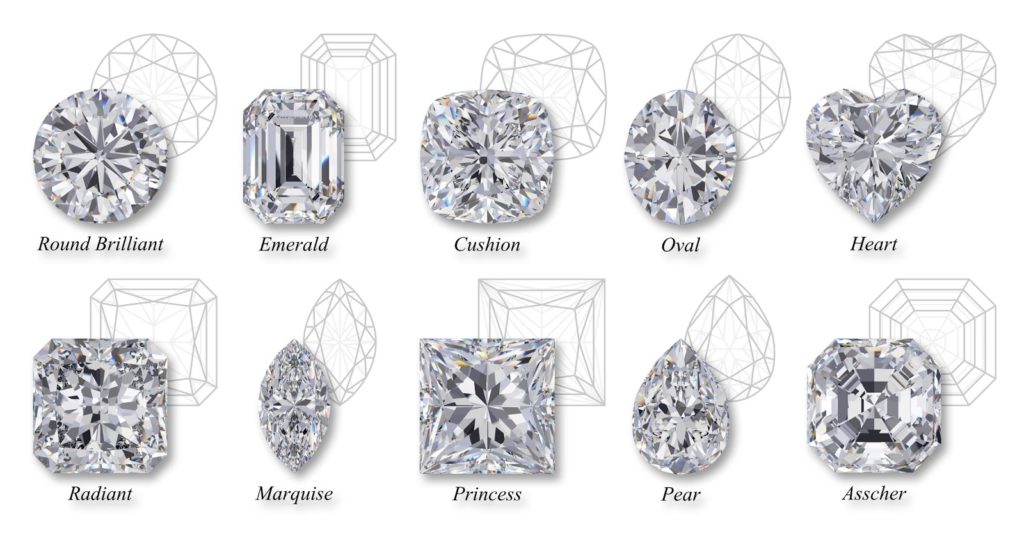
Clarity
The clarity of a diamond speaks to how few imperfections exist within and on the surface of the stone. Since diamonds are naturally formed deep inside the Earth, some are as old as 3 billion years. All diamonds will have inclusions based on the amount of magnification used, and if they are cleaned to 10X power, they will get a grade of Flawless or Internally Flawless. If the diamond has inclusions seen without magnification, it would be in the Imperfect or Included range (I1, I2, or I3 depending on the amount seen). It is common for these stones to feature slight blemishes ection or inclusions (internal imperfection).
The diamond clarity scale is divided into six categories:
- Flawless (FL): no blemishes or inclusions visible under magnification
- Internally Flawless (IF): no inclusions are present but may feature a few slight blemishes under magnification
- Very, Very Slightly Included (VVS1, VVS2): may include inclusions that are barely visible under magnification
- Very Slightly Included (VS1, VS2): includes inclusions not visible to the naked eye, but visible under magnification
- Slightly Included (SI1, SI2): included inclusions visible under magnification and occasionally to the naked eye
- Included (I1, I2, I3): included inclusions that are noticeable by the naked eye
Color
A diamond is often thought to be completely colorless, however, purely colorless diamonds are extremely rare, and as a result, expensive. Most diamonds feature a slight degree of yellow hue when viewed under magnification. The GIA grades diamond color on a scale from D to Z.
- Colorless (D-F): a colorless diamond feature no detectable hue
- Near Colorless (G-J): near colorless but does have a slight hue in color
- Faint Color (K-M): more noticeable to the naked eye possessing a warm color tint
- Very Light Color (N-R): feature a noticeable yellow hue to the naked eye
- Light Color (T-Z): clear visible yellow coloring of the diamond

Carat
A misconception about carat is that it refers to the size of the diamond. In actuality, carat only deals with the weight of the diamond and is a by-product of CUT. To break this down, we use millimeters. If a diamond is too heavy, it will have the carat weight, but not the size or sparkle. Each carat is divided into 100 points allowing for specific measurement of each diamond. (think of points as money. 100 cents equals $1.00). However, diamonds of the same carat size can range widely in price due to the other factors of cut, clarity, and color. Typically, the larger the carat size, the greater the price tag due to diamond size rarity.
Next… Picking a Setting
Once you’ve identified your forever stone, you need to decide on a setting. While the diamond can account for upwards of 90 percent of the total engagement ring price, the setting can make or break your love for your chosen diamond. The setting helps highlight the best features your diamond has to offer. Therefore, it is important to have an open mind when looking at example engagement bands.
A few things to consider when choosing a setting include your style preferences, but also your lifestyle. Individuals who work with their hands, or have active hobbies and habits need to take into account how much security the setting provides the stone.
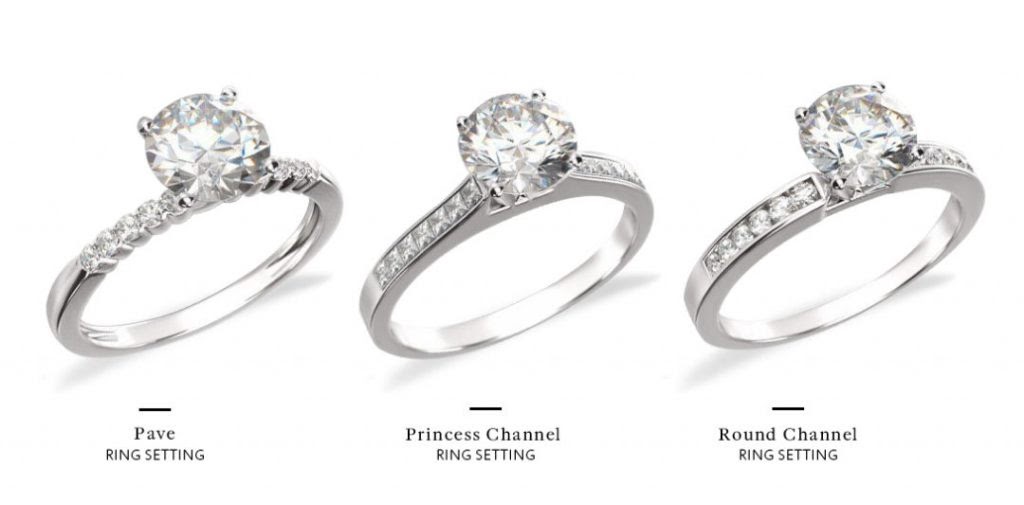
A few popular setting styles include:
Prong Setting
The prong setting is the most common setting type, featuring three to six “claws” that firmly hold the stone in place. This style provides the most light exposure to show off the ring’s shine, uses less metal (meaning a fasting diamond set and lower cost), and is easily cleaned.
Pavé Setting
A pavé setting provides a higher-end look on an engagement ring. With this setting, rows of tiny stones are placed surrounding the center diamond and then secured in place by white gold or platinum metal. This style gives the ring-wearer extra sparkle and seamless design flow between diamond and setting.
Bezel Setting
Simple and classic, the bezel setting is a metal rim with edges that surround and secure the stone in place. This setting provides ultimately diamond security and best protects from scratches and chips caused by everyday use.
Channel Setting
This setting provides a smooth and unobtrusive setting option for individuals. The channel setting places a row of stones, with no metal separation, between two horizontal parallel channels for part or all of the ring.
Bar Setting
The bar setting is a good choice for someone with an active lifestyle as it provides good protection for the diamond and does not protrude in a dangerous way. The setting involves a series of two or more thin vertical bars of metal that sit between each stone as it holds them in place.
Tension Setting
This modern setting style is when the engagement band firmly presses the metal sides against the stone — providing an almost floating in place appearance. This up and coming look allows the most light to enter the stone.
Gypsy Setting
While simple, the gypsy setting will withstand the test of time. This setting places the stone in the middle of a hole in the engagement band. Placed flush on the metal band, the stone does not protrude above the surface of the band, providing great security and protection from nicks and scratches.
Get Diamond Quality Proof
A quality diamond will hold its value and increase in value over time. You are investing in a lifelong relationship, so why not the center diamond. The mounting styles, the colors or the metal will change over time, but you can always re-mount or upgrade your investment years down the road. Many people are buying low quality diamonds and a high mark up or looking for a deal. These are warning signs for looking for a quality investment diamond. Our worst day for our customers is when we have to explain that the diamond they “got a good deal on” is a very low quality diamond and it’s not worth what they paid for it.
So, when shopping for engagement rings, we always recommend getting the proper documentation that ensures what you’re paying for is in fact the real diamond cut, color, clarity, and carat. Being such a big purchase, and serving as a life-long commitment to your partner, you want to verify the perfect engagement ring is a real engagement ring. Be sure that your diamond comes with a certificate of authenticity from either the Gemological Institute of America (GIA) or the American Gem Society (AGS).
Columbia, Missouri’s Engagement Ring Experts
We will help you figure out all the details for what you want to create and can stay within any budget. Whether the ring in question is a classic diamond solitaire or something a bit less traditional, when you work with KT Diamond the end product will be a completely custom engagement ring that you will love.
Our master jewelers and custom design process are second to none. Contact us to start your journey today. Follow the link below to view the gallery of beautiful custom engagement rings we’ve crafted for our clients.
Learn more about our Custom Design process or view some of our custom rings below.

